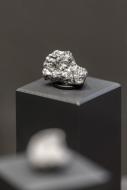Initial chemical and mineralogical investigations of the meteorites collected from the strewn field produced by the breakup of asteroid 2024 BX1, which passed through the atmosphere as a meteor on 21 January 2024 northwest of Berlin near Ribbeck, were successfully carried out at the Museum für Naturkunde (MfN). The meteorites belong to a rare group of achondrites called aubrites. This result was submitted to the Nomenclature Committee of the Meteoritical Society on 2 February 2024 for examination and confirmation.
This is only the eighth case worldwide in which the collision of an asteroid with Earth was predicted prior to atmospheric entry. Based on superb guidance by meteor astronomers from the Astronomical Institute of the Czech Academy of Sciences, who calculated how the meteorites were blown by the strong wind, a team of researchers and students from Museum für Naturkunde Berlin, German Aerospace Center, Freie Universität Berlin, Technische Universität Berlin and the SETI Institute (USA) have collected more than 20 meteorite samples for the Museum für Naturkunde's research collection over the past few days. The mineralogical and chemical composition of one of the samples was analyzed with the Museum für Naturkunde's electron microprobe. These measurements revealed that the meteorites are achondrites of the rare aubrite type.
A piece of the first aubrite ever collected on Earth is also in the museum's research collection. It fell on 14 September 1836 near Aubrés in France. "Based on a comparison against the Aubrés fall, we were able to make a rough classification of the Ribbeck meteorites relatively quickly," says Dr. Ansgar Greshake, scientific head of the museum's Meteorite Collection. "This underlines the immense importance of scientific collections for research. So far, there is only material from eleven observed aubrite falls in collections worldwide."
Aubrites do not look like typical meteorites. "Aubrites look more like a grayish granite and consist mainly of the magnesium silicates enstatite and forsterite," says Dr. Christopher Hamann, who was involved in the meteorite’s initial classification and is with the museum’s Solar System, Impacts and Meteorites department. "It contains hardly any iron and the fusion crust, a thin, tell-tale layer of quenched melt coating meteorites and which typically allows identifying them as such in the field, looks completely different than that of most other meteorites. Aubrites are therefore difficult to detect in the field."
Some of the Ribbeck meteorites that are now in the museum’s research collection will be displayed in the exhibition from 12 March 2024, but only for a few weeks, as the material is sensitive and is being further researched.
A video about the ongoing investigation of the meteorites at the Museum für Naturkunde Berlin is posted on the museum's YouTube channel as part of the "Museum Evolution" series.
Background
Scientits in the "Solar System, Impacts and Meteorites" department at Museum für Naturkunde Berlin reconstruct the formation history of and collisions among planetary bodies of our solar system, especially the Earth-like planets and small planetary bodies such as asteroids. These were formed more than 4.5 billion years ago through progressive collision and agglomeration of initially dust-sized particles that later grew to planets and moons. Processes of the initial phases of planetary accretion are primarily witnessed by chondritic meteorites, which have hardly been changed since their formation in the solar nebular, prior to the birth of planets. In contrast, achondrite meteorites such as the aubrites document later processes of planetary formation and evolution. As meteorites document planet-forming processes from more than 4.5 billion years until today, their study allows insights into the early solar system and the associated physical and chemical parameters.
The department therefore not only addresses the central scientific question of how our solar system, including its habitable planet Earth, developed into its current state, but also whether a cosmic transfer of organic material through the solar system could have laid the foundation for the emergence of life on Earth. With around 12,000 specimens of some 6,500 different meteorites, the museum's Meteorite Collection is central to answering these and other scientific questions.




